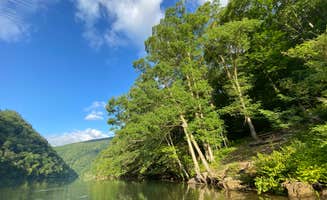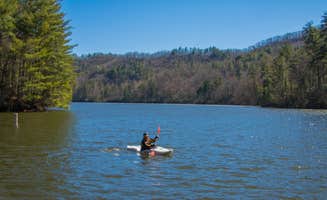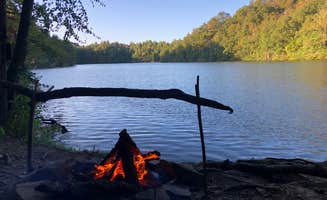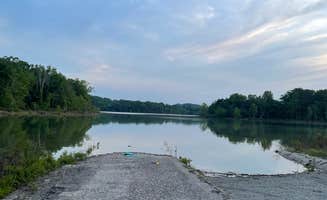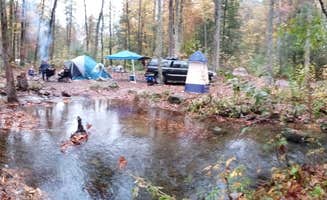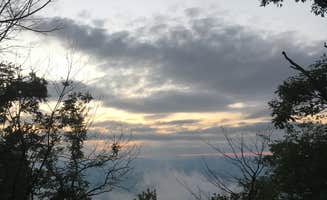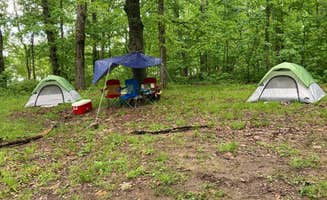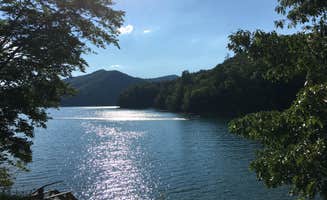Dispersed camping near Rockford, Tennessee gives campers access to the Cherokee and Nantahala National Forests, with elevations ranging from 1,200 to 5,500 feet throughout the region. These camping areas sit within the southern Appalachian ecosystem, characterized by mixed hardwood forests and abundant rainfall that feeds numerous creeks and waterways. Fall temperatures typically range from 40-70°F while summer months can reach 85-90°F with high humidity.
What to do
Kayaking and paddling access: At Calderwood Lake Primitive campground, campers can find excellent water recreation opportunities. "If you are willing to bring everything with you, pack everything out, and paddle multiple miles on a nonmotorized finger lake, this is this place for you!" reports Tyler J. The lake provides clear water with limited motorized traffic.
Swimming in natural pools: Several areas feature natural swimming holes near camp spots. At Calderwood Lake, Claire K. notes, "if you take [Slickrock trail] about 1.5 miles you'll reach Wolfcat falls which has a big swimming hole at the bottom." These swimming areas provide refreshing alternatives to developed pools.
Fishing opportunities: Multiple camping areas offer fishing access directly from campsites. At Lake Santeelah Dispersed, WDRoberson shared their experience: "Not very far to walk to reach the lake and the fishing wasn't bad at all. Bass and Bluegills." Fish populations vary seasonally with spring and fall typically producing better catches.
What campers like
Solitude and spacing: Campers consistently mention the privacy between sites as a major benefit. At Long Hungry Road Dispersed Campsites, Kaylee D. observed: "Sites are so spread out it feels like you're the only one on the lake!" This spacing creates a more immersive forest experience than typical campgrounds.
Lake views: Many dispersed campsites feature unobstructed water views. Robert W. describes Lake Santeelah Dispersed: "There are a handful of lots located right along the lake with a beautiful view of the mountains in the distance." These vantage points provide scenic backdrops particularly during sunrise and sunset.
Wildlife encounters: The remote nature of these sites increases wildlife viewing opportunities. At Long Hungry Road sites, Robert W. notes: "Lots of wildlife sounds at night. Also a random heard of cattle strols through every now and again." Bird watchers should look for the Tufted Titmouse, a small gray bird resembling a cardinal, as mentioned by Andy S.
What you should know
Limited facilities: Most sites have minimal or no amenities. At Harold Parrish Lower Camp, hikers should expect complete self-sufficiency. Claire K. warns about access challenges: "if you're thinking of kayaking or canoeing to these sites it's impossible because of the amount of small falls so you'll have to park your boat at the cove and leave it."
Varying road conditions: Access roads range significantly in quality. About Lake Santeelah, Alexandra cautions: "the road to get to Lake Santeetlah has endless sharp turns & drop-offs, would not recommend driving this in the dark." Some routes require high-clearance vehicles after rain.
Seasonal crowds: Popular areas fill quickly during peak seasons. Katie A. notes about Long Hungry Road: "The written driving directions from other reviews are helpful, it's a dirt road, but not too rough." Weekends from May through October typically see the highest usage rates.
Tips for camping with families
Kid-friendly water access: Look for sites with gradual water entry. At Sourwood Campground, Dan R. highlights that "The closeness to the river is the main attraction here. It's ever-present sounds make it easy to forget everything." These water features provide natural entertainment for children.
Site selection considerations: Some areas have more level ground than others. Victor S. notes about Sourwood: "A little rocky for the tents but we made it work. I did notice some much better spots for tents. Some sites were big, one of them maybe even big enough for a small gathering, but some were really small."
Pack-in necessities: No stores exist near most dispersed sites. When camping with families, remember Blake R.'s advice about Long Hungry Road: "Lots of firewood and enough space for 4 or 5 tents. Site 9 had a little trail down to the lake, 2 fire pits and a picnic table." Bringing extra supplies prevents lengthy drives for forgotten items.
Tips from RVers
Size limitations: Most dispersed sites cannot accommodate large RVs. At Bi-Color Campground, Nicholas mentions: "This camp is perfect for the fam as it can accommodate RV sized vehicles. Only word of caution is that the ground can get a bit muddy, so try to find something dry."
Leveling challenges: Many sites have uneven terrain. Michael W. cautions about Bi-Color Campground: "Dirt rd I, washboard out was north to Rock Creek campground steep downhill grade narrow. My opinion not for 5th wheel." Small trailers and truck campers fare better than larger rigs.
Turn-around space: Consider your ability to maneuver when selecting sites. About Sourwood Campground, Victor S. advises: "It would absolutely NOT be a good location for a class A motorhome but maybe some of the smaller class C's could get settled in there. I would not like to try to get a larger camper or 5th wheel in there, way too tight to turn around."


